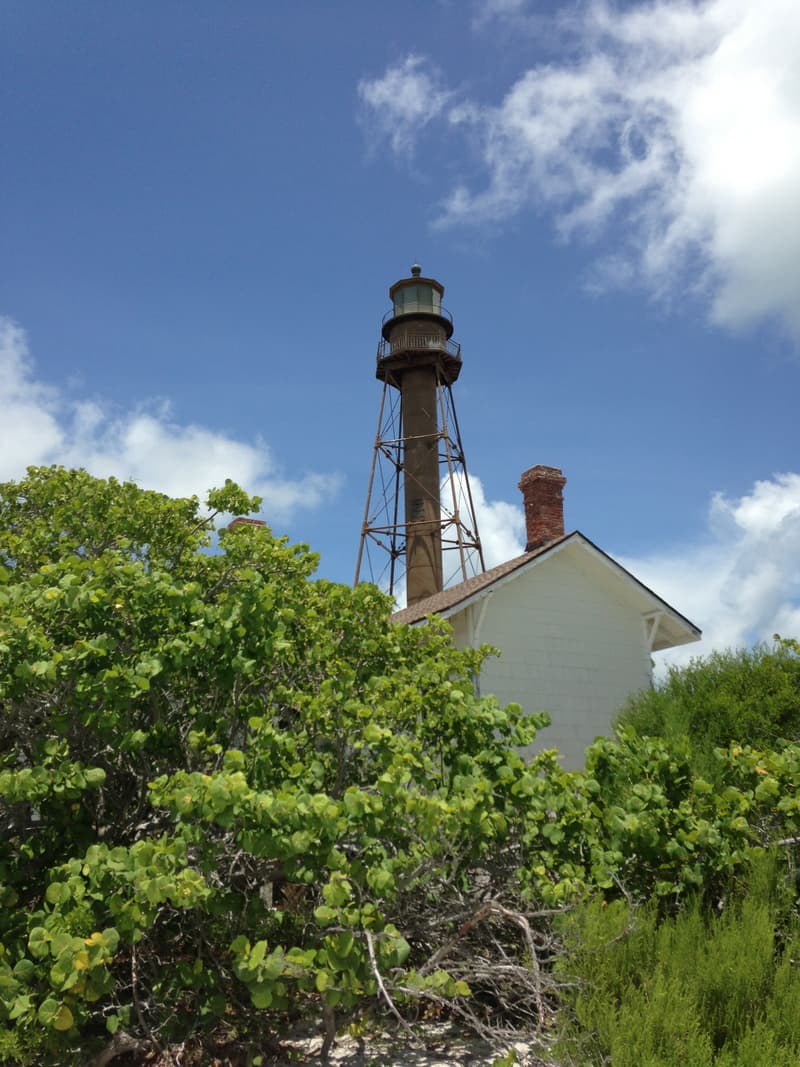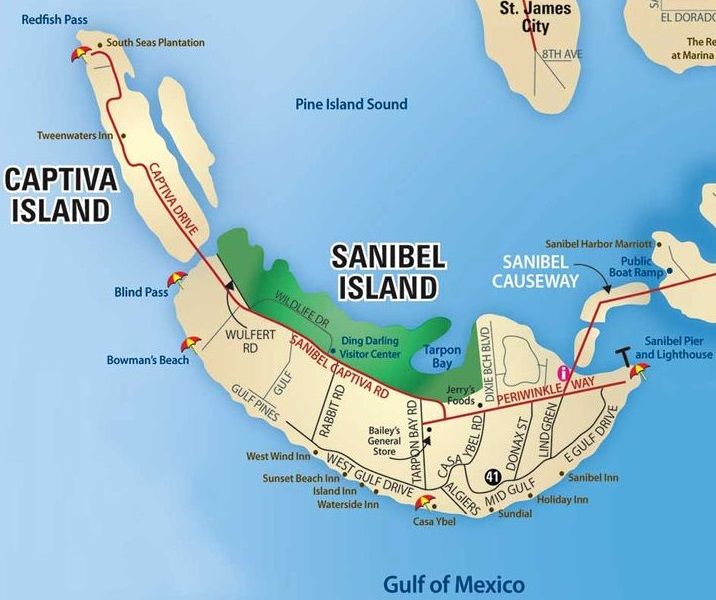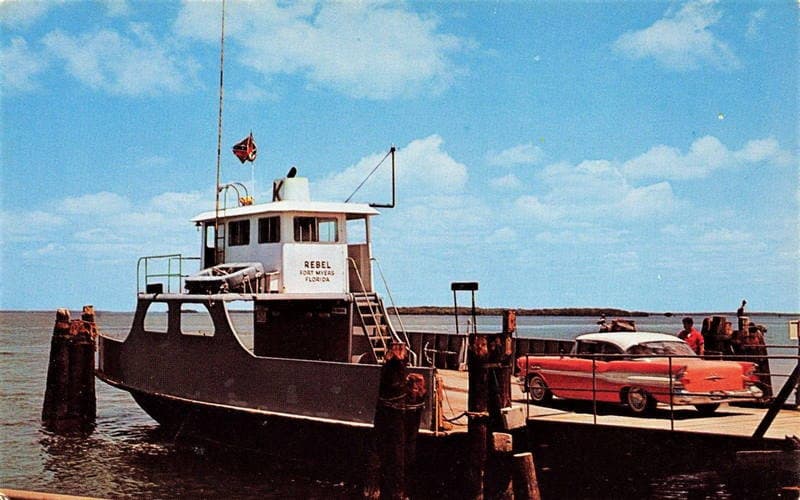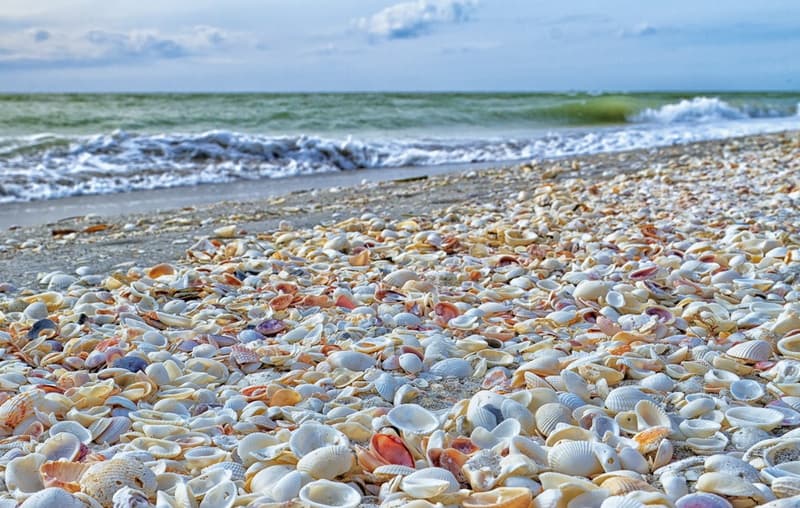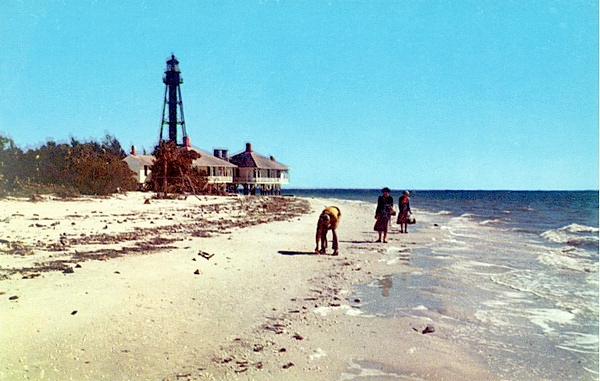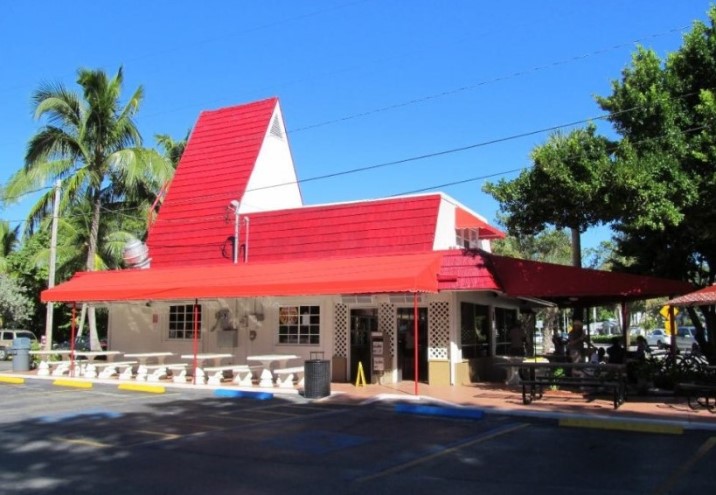- Home
- Florida Towns
- Sanibel Island
SANIBEL ISLAND, FLORIDA
By Mike Miller Updated October 9, 2022
SANIBEL SUFFERED SEVERE DAMAGE FROM HURRICANE IAN ON SEPTEMBER 28, 2022. THE VIDEO BELOW SHOWS THE EXTENT OF THE DESTRUCTION.
Sanibel, Florida Things To Do, Lodging, Dining, & Real Estate At End Of Article
Sanibel is an incorporated island city on the Gulf of Mexico in Lee County, Florida. It has a population of 7,400.
The island is connected to much smaller Captiva Island on its north end by a short bridge over Blind Pass.
The combined islands are connected to the mainland by a long toll bridge and causeway to the mainland at Punta Rassa near Fort Myers.
There is a toll to get on the island, but leaving the island is free. The toll is $6.00 for cars, $2.00 for motorcycles, and free for bicycles.
SANIBEL ISLAND, FLORIDA HISTORY
Sanibel was an important settlement of the powerful Calusa native American tribe who dominated most of Southwest Florida in the years before European colonization.
For thousands of years, Captiva and Sanibel were one island.
Hurricanes broke passes through from the Gulf to Pine Island Sound creating three islands: Sanibel, Captiva, and North Captiva.
The Spanish were the first European settlers on the island, and on an early map a harbor was shown on the island as "Puerto de S. Nibel."
There are many theories about how Sanibel got its final name.
Along with nearby islands Captiva, Useppa, and Gasparilla, Sanibel is linked in the various legends of Jose Gaspar the pirate known as Jose Gaspar whose nickname was "Gasparilla."
Sanibel is also reputed to be a hideout for the pirate known as "Black Caeser," who was described as a former Haitian slave who escaped to become a pirate.
The first settlement in modern times was created by the Florida Peninsular Land Company in 1832, but it failed and was abandoned in 1849.
Settlers began to come again as a result of the Homestead Act of 1862, and a lighthouse was built in 1884.
Although quite a few pioneers became small farmers and homesteaded their 160 acres, the population remained very small for years because of the limited access to the mainland.
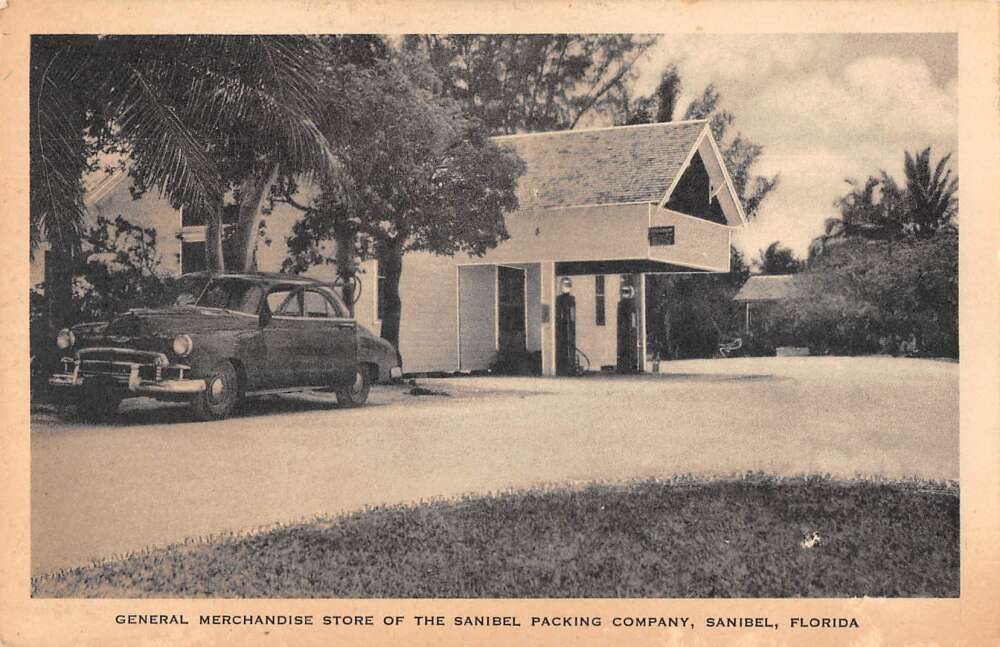
It wasn't until the end of World War Two that the population began to increase slowly.
A few vacation homes were built that were occupied in the winter months, but stayed empty the rest of the year.
The only way to get to and from Sanibel was by car ferry from the mainland or by private boat.
The quiet days of Sanibel were about to end not long after Hugo Lindgren, a Swedish born investor, bought a large tract of land on the island.
In the 1950s the population of Sanibel was only 250 permanent residents.
Mr. Lindgren believed a bridge to the mainland would enhance his investment. He spent money on feasibility studies, and fought intense opposition from environmentalists to get the financing and permitting for a bridge.
The causeway and bridge were completed in 1963 and immediately began to drastically change Sanibel.
Developers and builders swarmed onto the island and quickly built condominiums, hotels, and residential subdivisions.
SANIBEL ISLAND, FLORIDA TODAY
The City of Sanibel was formed in 1974 and the citizens quickly put a serious slowdown and restrictions on the development.
The only tall buildings on the island were built in the period before the city was formed.
Most condominiums and hotels on Sanibel now are only two or three stories at the most.
The City also prohibited chain and fast food restaurants.
There are only two on the island, Dairy Queen and Subway, that were in operation before the City passed the regulation.
Today the causeway provides easy access to the island and both Sanibel and Captiva have become tourist magnets.
The island is famous for its shelling beaches and wildlife refuges.
The term "Sanibel Stoop" refers to the hunched over position the shell hunters assume when discovering a great shell they want to pick up.
About half of the land area of Sanibel is preserved in wildlife refuges. The largest of these is the J. N. "Ding" Darling National Wildlife Refuge.
This 5,200 acre refuge was founded in 1976 and is one of the largest undeveloped mangrove systems in the country. The refuge is a popular tourist attraction, especially to bird lovers.
The refuge is a well known bird watching location because of the thousands of migratory birds that stop here.
Learn more about Florida birds.
Sanibel Island is joined to unincorporated Capitva Island by a bridge over Blind Pass. It has many things in common with Sanibel, but has its own unique personality and historic communities. You can read about Captiva Island by clicking the link near the bottom of this page.
Sanibel Island extends in a westerly direction once you enter from the causeway, and most of the actual town is on the eastern end near the causeway entrance.
Most of the stores and restaurants are located along Periwinkle Way, the main thoroughfare through the town. Most of the hotels and condominiums are on East, Mid, and West Gulf Drives.
These streets run parallel to Periwinkle along the Gulf of Mexico.
Periwinkle Drive and Sanibel-Capitva Road become very congested during tourist season and on weekends. Traffic creeps and crawls, but at least the scenery is beautiful.
A great place to learn more about the history of Sanibel is at the Sanibel Historical Museum and Village.
In addition to several historic buildings, there is a beautiful Heritage Trail with a map so you can take a drive or hike that will give you a real sense of the town's past.
The Bailey-Matthews National Shell Museum is a must visit for shell lovers. They have a huge collection of shells, and also offer close up looks of the mollusks that create the shell. You can even touch them.
Tourists also love to see the Giant Pacific Octopus.
RECOMMENDED SANIBEL RESTAURANT
There are dozens of fantastic restaurants of all sorts on Sanibel and neighboring Captiva. Most of them are fairly expensive, so if I'm on Sanibel just for the day I liked to eat at one of the only two fast food restaurants on the island:
Dairy Queen
1046 Periwinkle Way
Sanibel Island, FL 33957
Tel: 239-472-1170
There is something enchanting about sitting outside and chomping on a burger at this small restaurant that seems so out of place on upscale Sanibel.
The food and ice cream is just about the same as at any other Dairy Queen, but it's the location that makes this one different.
THINGS TO DO IN SANIBEL, FLORIDA
J.N. "Ding" Darling National Wildlife Refuge
1 Wildlife Dr, Sanibel, FL 33957 | (239) 472-1100
J.N. "Ding" Darling National Wildlife Refuge, discussed earlier, is a natural paradise on Sanibel Island. We enjoy exploring the miles of trails that wind through mangroves and wetlands.
Visitors like spotting a variety of wildlife, including alligators, manatees, and numerous bird species. The refuge is perfect for hiking, biking, and birdwatching. The scenic drive offers a great way to see the beauty of the area from the comfort of your car.
The education center provides interesting exhibits and information about the local ecosystem. It's a must-visit for nature lovers and families looking to experience Florida's natural beauty.
Sanibel Lighthouse
110 Periwinkle Way, Sanibel, FL 33957 | (239) 472-0345
The Sanibel Lighthouse, pictured earlier, is a historic landmark and a favorite spot for visitors. It’s located in Lighthouse Beach Park. We enjoy walking along the beach and taking in the beautiful views of the Gulf of Mexico.
Guests like watching for dolphins playing in the water. The lighthouse, built in 1884, is a picturesque backdrop for photos. The surrounding park offers picnic areas and nature trails. It's a great place to relax and enjoy the serene coastal atmosphere.
Whether you're fishing, beachcombing, or just enjoying the view, the Sanibel Lighthouse area is a wonderful destination.
Bailey-Matthews National Shell Museum & Aquarium
3075 Sanibel Captiva Rd, Sanibel, FL 33957 | (239) 395-2233
The Bailey-Matthews National Shell Museum & Aquarium, discussed earlier, is a unique and fascinating attraction. We enjoy learning about the incredible variety of shells found on Sanibel Island and around the world.
Visitors like the interactive exhibits and hands-on displays. The museum's collection includes rare and beautiful shells from all over the globe. The educational programs and live tank displays are perfect for kids and adults alike.
It's a great place to gain a deeper understanding of the island's famous shelling opportunities. The friendly staff and informative exhibits make it a must-visit for anyone interested in marine life.
Sanibel Historical Museum and Village
950 Dunlop Rd, Sanibel, FL 33957 | (239) 472-4648
Sanibel Historical Museum and Village, mentioned earlier, offers a charming look into the island's past. We enjoy exploring the restored buildings, which include a schoolhouse, general store, and pioneer homes.
Visitors like the guided tours that provide insights into the early settlers' lives. The village is beautifully maintained, with lush gardens and historical artifacts. It's a wonderful place to learn about Sanibel's history and heritage.
The friendly volunteers are always ready to share stories and answer questions. It's an engaging and educational experience for all ages, making it a favorite destination for history enthusiasts.
Tarpon Bay Explorers
900 Tarpon Bay Rd, Sanibel, FL 33957 | (239) 472-8900
Tarpon Bay Explorers is the perfect spot for outdoor adventure. We enjoy kayaking and paddleboarding through the calm waters of Tarpon Bay. Visitors like the guided eco-tours that offer a chance to see wildlife up close, including manatees, dolphins, and various bird species.
The rental equipment is top-notch, and the staff is knowledgeable and friendly. It's a fantastic way to experience the natural beauty of Sanibel Island. The scenic boat tours are also popular, providing a relaxing way to explore the bay. Whether you're paddling, boating, or fishing, Tarpon Bay Explorers offers something for everyone.
Bowman's Beach
1700 Bowman's Beach Rd, Sanibel, FL 33957 | (239) 395-1860
Bowman's Beach is one of our favorite spots on Sanibel Island. We enjoy the pristine white sand and clear blue waters. Visitors like the peaceful atmosphere, perfect for sunbathing, swimming, and shelling.
The beach offers plenty of amenities, including picnic areas, barbecue grills, and restrooms. The walking trails through the dunes add to the charm. It's a great place for a family outing or a quiet day by the sea.
The sunsets here are spectacular, making it a popular spot for evening strolls. Bowman's Beach is a true gem, offering a serene and beautiful coastal experience.
BIG ARTS Sanibel Island
900 Dunlop Rd, Sanibel, FL 33957 | (239) 395-0900
BIG ARTS Sanibel Island is a vibrant cultural hub. We enjoy the diverse range of events and performances, including concerts, theater productions, and art exhibits. Visitors like the intimate setting and high-quality programming.
The center also offers workshops and classes in various arts disciplines. It's a great place to explore your creativity or enjoy a night of entertainment. The friendly staff and welcoming atmosphere make every visit enjoyable.
BIG ARTS is a cornerstone of the island's cultural scene, providing enriching experiences for both locals and visitors. It's a must-visit for anyone interested in the arts.
Sanibel-Captiva Conservation Foundation (SCCF)
3333 Sanibel Captiva Rd, Sanibel, FL 33957 | (239) 472-2329
The Sanibel-Captiva Conservation Foundation (SCCF) is dedicated to preserving the natural resources of Sanibel Island. We enjoy exploring the nature trails and learning about the local flora and fauna.
Visitors like the educational programs and exhibits that highlight the island's unique ecosystems. The foundation's work in land preservation, water quality, and wildlife conservation is impressive. It's a great place to connect with nature and learn about environmental stewardship.
The SCCF's Native Plant Nursery is also a favorite, offering a variety of plants for your garden. It's a wonderful destination for nature lovers and conservation enthusiasts.
Clinic for the Rehabilitation of Wildlife (CROW)
3883 Sanibel Captiva Rd, Sanibel, FL 33957 | (239) 472-3644
CROW is an inspiring wildlife rehabilitation center. We enjoy visiting the education center to learn about the rescue and care of injured animals. Visitors like the live animal presentations and interactive exhibits.
The center's mission to rehabilitate and release wildlife back into their natural habitats is heartwarming. It's a great place to see wildlife up close and learn about conservation efforts.
The dedicated staff and volunteers are passionate about their work, making every visit informative and enjoyable. It's a must-see for anyone interested in wildlife and environmental conservation.
Sanibel Island Farmers Market
800 Dunlop Rd, Sanibel, FL 33957 | (239) 218-1055
The Sanibel Island Farmers Market is a delightful weekly event held in Sanibel City Hall. We enjoy browsing the fresh produce, baked goods, and local crafts. Visitors like the friendly vendors and the variety of products available.
The market is a great place to sample local flavors and pick up unique gifts. It's also a wonderful community gathering spot, with a lively and welcoming atmosphere. The fresh seafood and homemade treats are particularly popular.
It's a perfect way to spend a Sunday morning, enjoying the best that Sanibel Island has to offer. The market is a favorite among locals and visitors alike. It is open from October through the end of May, 9am – 1pm, every Sunday.
ALL ABOUT SANIBEL, FLORIDA
SANIBEL, FLORIDA INTERACTIVE GOOGLE MAP

Florida is the fastest-growing state in the United States and also the fastest-changing. If you see anything in this article that has changed or is in error, please let me know.
Thousands of Florida fans subscribe to our free daily Ezine, Florida Heritage Travel and we have 130,000 followers on Facebook.
By Mike Miller, Copyright 2009-2025
Florida-Back-Roads-Travel.com
Florida Back Roads Travel is not affiliated with or endorsed by Backroads, a California-based tour operator which arranges and conducts travel programs throughout the world.
